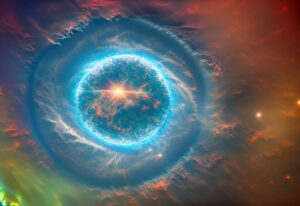Terraforming refers to transforming a planet or a moon into a habitable environment supporting human life. The concept of terraforming has been around for quite some time, with early science fiction writers like H.G. Wells and Olaf Stapledon exploring the idea of transforming other planets into Earth-like worlds. “Terraforming” was first coined by science fiction writer Jack Williamson in his 1942 short story “Collision Orbit.”
How it began
However, the idea of terraforming has now moved beyond science fiction and has become a topic of scientific research and study. Scientists and researchers have been exploring terraforming for decades, and several theoretical studies have examined the feasibility of terraforming other planets.
The most promising candidate for terraforming is Mars. Mars has a thin atmosphere that lacks the protective magnetic field of Earth, which means it is subjected to harsh solar and cosmic radiation. The surface of Mars is also barren and bleak, with temperatures ranging from -195°C (-319°F) to 20°C (68°F) at the equator. The lack of liquid water and a breathable atmosphere makes it impossible for humans to survive on the planet without some form of protective gear or artificial environment.
To make Mars habitable, scientists have proposed several terraforming techniques. One of the most popular methods is to increase the planet’s atmospheric pressure by releasing greenhouse gases into the atmosphere. The greenhouse gases would trap heat from the Sun and warm the planet’s surface, melting the frozen carbon dioxide and water ice at the poles and creating liquid water. The increased atmospheric pressure would protect the earth from harmful solar and cosmic radiation.
From science fiction to science
British scientist James Lovelock proposed the Gaia hypothesis in the 1970s. The theory suggests that the Earth and its biosphere, consisting of all living organisms, can be viewed as an automated system that actively maintains the conditions for life. This system is believed to be capable of responding to external influences, such as changes in atmospheric composition or temperature, in a way that preserves the planet’s habitability. The theory is named after the Greek goddess Gaia, who was believed to embody the Earth itself. While some scientists have criticized the Gaia hypothesis for its lack of empirical evidence, it has also gained significant support from others. It has influenced the study of Earth’s ecology and its relationship with the surrounding environment.
Habitability requirements refer to the conditions necessary for a planet or celestial body to sustain life as we know it. These requirements include factors such as the presence of water, a stable atmosphere, and a suitable temperature range.
One of the critical habitability requirements is liquid water, which is essential for developing and sustaining life. The planet must also be at a suitable distance from its star to maintain a temperature range that allows liquid water to exist.
Another critical factor is the planet’s atmosphere, which must be stable and protect life from harmful radiation and cosmic rays. A sufficient level of atmospheric pressure is also necessary to prevent water from evaporating into space.
Other habitability requirements include a stable and suitable geological activity, availability of nutrients, and a magnetic field to protect from solar winds. Understanding these requirements is essential for identifying potentially habitable planets and planning future missions to explore and colonize other worlds.
Another proposed method is to use a process called “terraforming by bacteria.” This endeavor involves introducing hardy bacteria or other microorganisms to the Martian environment, breaking down the planet’s abundant carbon dioxide and converting it into oxygen. The oxygen produced by these microorganisms would eventually accumulate in the atmosphere and create a breathable environment for humans.
However, terraforming Mars is challenging, and it is still being determined how long it will take to achieve this. Most estimates suggest that it could take several centuries to terraform Mars, with some estimates ranging from 100 to 10,000 years.
In the short term, terraforming Mars could have several benefits. It could provide a new frontier for human exploration and colonization, opening up new scientific research and discovery opportunities. It could also offer a backup plan for humanity in a global catastrophe.
However, there are also potential risks and downsides to terraforming Mars. One of the biggest concerns is the potential impact on the planet’s existing ecosystem, if any. Mars may have microbial life or other forms of life that we have yet to discover, and terraforming the world could potentially wipe out these organisms. There are also concerns about the long-term sustainability of a terraformed Mars, particularly in maintaining a breathable atmosphere and preventing the greenhouse effect from running out of control.
While Mars is the most extensively studied and discussed planet in terms of terraforming, other planets and moons have also been considered potential candidates.
One such planet is Venus, which is closer to the Sun than Earth and therefore has a higher surface temperature, making it inhospitable to life as we know it. However, some scientists have proposed that it may be possible to cool down Venus by using giant mirrors or other means to reflect sunlight into space, thereby reducing the amount of solar energy that reaches the planet’s surface. This approach would require extensive technological advancements, but if successful, it could lead to a habitable Venus.
Another potential candidate for terraforming is Titan, a moon of Saturn. While Titan is much colder than Mars and Venus, it has a thick atmosphere that could be converted into a more Earth-like environment. This undertaking could involve introducing microbes or other organisms that could artificially convert the nitrogen-rich atmosphere into one with more oxygen and warm up the moon’s surface.
Other candidates for terraforming include some of the moons of Jupiter and Saturn, such as Europa, Ganymede, and Enceladus, which are believed to have subsurface oceans that could support life. However, terraforming these moons would likely be even more challenging than terraforming planets, as they lack an atmosphere and are exposed to harsh radiation from their host planets.
Summary
In conclusion, terraforming is a fascinating idea that has captured the imagination of scientists and science fiction writers for decades. While transforming other planets into habitable worlds may seem far-fetched, significant progress has been made in recent years. There are several proposed methods for terraforming Mars. However, the process will likely be slow and challenging, with potential risks and downsides. Regardless, the idea of terraforming remains an exciting and thought-provoking area of scientific research that could have significant implications for the future of humanity.
Recommended articles
★ ★ ★ ★ ★
This is an original article published exclusively by Space Expert. You may cite it as:
"Terraforming: A new home beyond Earth" in Space Expert, 2024
Permalink: https://space-expert/terraforming-a-new-home-beyond-earth/




Your article helped me a lot, is there any more related content? Thanks!
Your point of view caught my eye and was very interesting. Thanks. I have a question for you.
Your point of view caught my eye and was very interesting. Thanks. I have a question for you. https://www.binance.com/sv/register?ref=V2H9AFPY
I am an investor of gate io, I have consulted a lot of information, I hope to upgrade my investment strategy with a new model. Your article creation ideas have given me a lot of inspiration, but I still have some doubts. I wonder if you can help me? Thanks.
Your article made me suddenly realize that I am writing a thesis on gate.io. After reading your article, I have a different way of thinking, thank you. However, I still have some doubts, can you help me? Thanks.
After reading your article, I have some doubts about gate.io. I don’t know if you’re free? I would like to consult with you. thank you.
Thanks for sharing. I read many of your blog posts, cool, your blog is very good.
Thank you very much for sharing. Your article was very helpful for me to build a paper on gate.io. After reading your article, I think the idea is very good and the creative techniques are also very innovative. However, I have some different opinions, and I will continue to follow your reply.
I am a student of BAK College. The recent paper competition gave me a lot of headaches, and I checked a lot of information. Finally, after reading your article, it suddenly dawned on me that I can still have such an idea. grateful. But I still have some questions, hope you can help me.
Your point of view caught my eye and was very interesting. Thanks. I have a question for you. https://accounts.binance.com/en/register-person?ref=P9L9FQKY
The point of view of your article has taught me a lot, and I already know how to improve the paper on gate.oi, thank you. https://www.gate.io/uk/signup/XwNAU
I have read your article carefully and I agree with you very much. This has provided a great help for my thesis writing, and I will seriously improve it. However, I don’t know much about a certain place. Can you help me? https://www.gate.io/zh-tw/signup/XwNAU
Can you be more specific about the content of your enticle? After reading it, I still have some doubts. Hope you can help me. https://accounts.binance.com/en/register-person?ref=P9L9FQKY
I may need your help. I tried many ways but couldn’t solve it, but after reading your article, I think you have a way to help me. I’m looking forward for your reply. Thanks.
Reading your article has greatly helped me, and I agree with you. But I still have some questions. Can you help me? I will pay attention to your answer. thank you.
Very nice post. I just stumbled upon your blog and wanted to say that I’ve really enjoyed browsing your blog posts. In any case I’ll be subscribing to your feed and I hope you write again soon!
I don’t think the title of your article matches the content lol. Just kidding, mainly because I had some doubts after reading the article. https://www.binance.com/pt-PT/register?ref=UM6SMJM3
Your article helped me a lot, is there any more related content? Thanks! https://www.binance.com/pt-PT/register?ref=DB40ITMB
I don’t think the title of your article matches the content lol. Just kidding, mainly because I had some doubts after reading the article. https://accounts.binance.com/vi/register?ref=GJY4VW8W
Your article gave me a lot of inspiration, I hope you can explain your point of view in more detail, because I have some doubts, thank you.
Your article gave me a lot of inspiration, I hope you can explain your point of view in more detail, because I have some doubts, thank you.
Nice post. I was checking continuously this blog and I’m impressed! Extremely helpful info particularly the last part 🙂 I care for such information a lot. I was looking for this certain information for a very long time. Thank you and best of luck.
Your article helped me a lot, is there any more related content? Thanks! https://www.binance.info/de-CH/join?ref=T7KCZASX
I don’t think the title of your article matches the content lol. Just kidding, mainly because I had some doubts after reading the article. https://www.binance.info/uk-UA/join?ref=PORL8W0Z
Your article helped me a lot, is there any more related content? Thanks! https://www.binance.info/sk/join?ref=YY80CKRN
I don’t think the title of your article matches the content lol. Just kidding, mainly because I had some doubts after reading the article. https://www.binance.com/zh-TC/join?ref=T7KCZASX
I don’t think the title of your article matches the content lol. Just kidding, mainly because I had some doubts after reading the article. https://www.binance.info/bg/join?ref=JHQQKNKN
I don’t think the title of your article matches the content lol. Just kidding, mainly because I had some doubts after reading the article. https://accounts.binance.com/en/register?ref=VDVEQ78S
Your point of view caught my eye and was very interesting. Thanks. I have a question for you. https://accounts.binance.com/ph/register-person?ref=VDVEQ78S
Thanks for sharing. I read many of your blog posts, cool, your blog is very good.
Can you be more specific about the content of your article? After reading it, I still have some doubts. Hope you can help me.
Howdy! This post couldn’t be written any better! Reading this post reminds me of my old room mate! He always kept talking about this. I will forward this page to him. Fairly certain he will have a good read. Thanks for sharing!
I don’t think the title of your article matches the content lol. Just kidding, mainly because I had some doubts after reading the article.